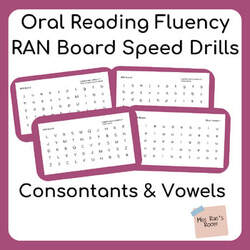|
7/12/2023 2 Comments Boost Reading Fluency with RAN Board Drills: A Coordinated Approach for TeachersDiscover how RAN Board Drills can significantly improve reading fluency in students. Learn how to implement a coordinated approach, including structured literacy instruction, advanced phonemic awareness skills, explicit phonics instruction, and engaging RAN drills using RAN boards. Enhance automaticity, decoding skills, and reading tracking while empowering students with the tools to become fluent readers. Get ready to elevate your teaching and witness remarkable progress in reading fluency! Are you searching for an effective method to enhance your students' reading fluency? Look no further! In this blog, we'll dive into the world of Rapid Automatized Naming (RAN) and introduce you to a powerful tool that can revolutionize your teaching approach: RAN Board Drills. In this era of advancing literacy instruction, RAN has emerged as a key predictor of students' fluency and overall reading abilities. But what exactly is RAN, and how does it impact reading proficiency? Whether you're a seasoned educator or a passionate parent, understanding the impact of RAN on reading skills is crucial. So let’s get some knowledge to enhance our teacher powers! What is Rapid automatized naming (RAN)?: Rapid automatized naming (RAN) is a task that measures how quickly students can name aloud objects, pictures, colors, or symbols (letters or digits). RAN is considered to be a strong predictor of a student’s fluency and later ability to read. In particular, RAN for letters and digits (numbers) correlate more strongly with reading skills. Poor RAN is often associated with reading difficulties in students. RAN is a great predictor of success, but it is not what you need to teach because well, we can’t really. Research has shown that RAN training does not improve reading. But while research suggests that RAN training alone may not directly improve reading skills, there are strategies that can enhance overall fluency and integrate reading skills for students with lagging RAN skills. Maryanne Wolf has concluded that if you want students to demonstrate fluent comprehension, teachers must first, implement a structured literacy approach to reading and second, teach with an emphasis on a coordinated approach to reading fluency. Structured Literacy Approach to Reading:The Structured Literacy approach to reading is considered to be the best methodology for improving students’ oral reading fluency. Implement a systematic and explicit approach that focuses on teaching the structure of language, including phonology, morphology, and syntax. This approach provides structured instruction in phonemic awareness, phonics, and decoding skills to develop a strong foundation for reading. Teaching oral reading fluency through activities like repeated reading, Wolf argues, may show a positive effect on fluent reading, but it may only lead to faster reading, rather than more coordinated or fluent reading.  At the word-level, readers must attend to the individual word in a text. Word-Level reading skills are based upon phonological/phonemic skills. Poor access to phonemes in spoken words negatively affects reading development. Such difficulties affect phonic development, sight word acquisition, and fluency. So our intervention instruction must be that coordinated approach to teaching reading fluency that Wolf references. Coordinated Approach to Reading Fluency: A coordinated approach to reading fluency should target automaticity of advanced phonemic awareness skills, explicit instruction in lagging phonics skills, direct fluency instruction, and include RAN charts, word part and word drills, memory strategies, and games! One way, in particular, to improve a student’s weak RAN skills’ impact on reading is to implement RAN Drills using RAN boards! RAN Drills:RAN drills target automaticity with word reading for students. The goal is for a student to see a word and be able to automatically read it. When a student encounters an unfamiliar word, the goal shifts to being able to efficiently and quickly decode it using acquired skill knowledge. This improves students’ reading fluency, which also improves students’ reading comprehension. Once students learn a phonics concept like the letter combinations of c and h make the /ch/ sound like in the word chat, they should practice this skill so that it becomes automatic. Drills for automaticity can support this. Start with letter-sound correspondence drills. Then, move to words containing the learned skill (and include previously learned skills in the words only). So if a student knows the consonant and short vowel sounds to date include words like /chat/, /much/, and /chin/, but do not include words like /change/ or /cherries/. Once word automaticity is strong, move to phrase (i.e. /such luck/), sentence (i.e. /I had such luck./) and then, paragraph reading using decodables with the learned skill. RAN Board Drills: RAN Boards are a tool teachers can use to teach reading fluency. RAN Boards can be utilized to enhance automaticity in letter-sound correspondence, word parts (such as /am/ and /ip/), and whole words that incorporate previously learned skills. This helps students improve their retrieval of information, or automaticity! The basic idea of RAN Board Drills is that you have a limited amount of items on the board and that they repeat over and over. Students practice reading the entire chart as fast as they can. You can time students, and track their time for progress monitoring. You can read more about how to progress monitor students HERE on my blog: Progress Monitoring Special Education Students It is really like giving students a stack of flashcards, but with the same letters, word parts, words, phrases, or sentences written several times on lots of different flashcards for lots of practice. The difference is that RAN boards also embed book or text reading skills by having students read the letters, word parts, or words from left to right, supporting their reading tracking. You can use THIS template to create your own RAN Board Drills or grab some pre-made ones for consonants and vowels HERE and CVC words HERE! In conclusion, RAN Board Drills emerge as an indispensable tool, igniting the flames of students' reading fluency and propelling them towards remarkable progress. When coupled with the power of a Structured Literacy approach to teaching reading, the impact is truly transformative. Through the systematic integration of RAN Board Drills, students embark on a journey of accelerated growth, witnessing significant improvements in their overall reading success. With each drill, students unlock the door to fluency, enabling them to navigate the written word with ease, confidence, and unwavering comprehension. The harmonious synergy between RAN Board Drills and a Structured Literacy approach lays the foundation for a brighter future, where every student can embrace the joys and rewards of reading with open arms. Happy & Healthy Teaching! Miss Rae Related Resources...Related Blogs...
2 Comments
"RAN board drills offer an effective strategy for teachers to enhance reading fluency. By coordinating these exercises, educators can systematically improve students' word recognition skills, ultimately fostering better comprehension. This approach, when incorporated into teaching methods, can significantly benefit students' reading abilities."
Reply
Your comment will be posted after it is approved.
Leave a Reply. |
CategoriesAll Comprehension CoPlanning CoTeaching Directed Reading DIY Fluency Fountas & Pinnell Graphic Organizers Guided Reading Lesson Planning Multi-Tiered Systems Of Support Phonological Awareness RAN Read And Respond Reading Reading Assessments Reading Comprehension Response To Intervention RTI Science Of Reading Science Of Reading For Special Education Teachers Special Education Special Education Eligibility Special Education Lesson Planning Teaching Strategy Visualizing & Verbalizing Visual Texts Vocabulary Writing Writing In Response To Reading |










 RSS Feed
RSS Feed